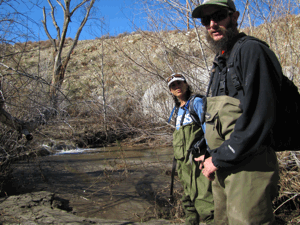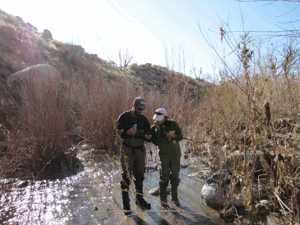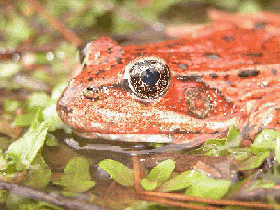Endangered Frogs Face New Threats
Air Date: Week of February 19, 2010

Backlin and Gallegos stand before what was once a rich habitat for frogs. Now, rushing water has destroyed the quiet creek. (Photo: Ashley Ahearn)
The California red-legged frogs miraculously survived fires that burned the hills outside of Los Angeles for five weeks last fall. But scientists now fear the threatened species may not have escaped from the recent heavy rains and mudslides. Producer Ashley Ahearn heads to the Angeles National Forest with a team of ecologists to search for the red-legged frogs.
Transcript
YOUNG: Well another endangered species story is unfolding in the hills of southern California. You remember those huge fires last fall just outside Los Angeles – two firefighters were killed and nearly ninety homes lost. But amid the ashes and blackened stumps, one good-news story emerged. While assessing the ecological damage, biologists stumbled upon a creek teeming with about 300 of the most endangered frogs in the state – the red-legged frog.
The excitement soon turned to fear when heavy rains hit the area and mudslides threatened the frog’s fragile hideout. Ashley Ahearn headed into the Angeles National Forest with a team of researchers to find out if the frogs can bounce back.
[TRUCK PASSING, RUSTLING AROUND IN TRUCK, GATHERING SUPPLIES]
AHEARN: On a dusty road on the northern side of the Angeles National Forest, Adam Backlin rustles around in the back of his SUV. Backlin, an ecologist with the U.S. Geological Survey, grabs his gear and wiggles into a pair of waders.
BACKLIN: I don’t know how to describe it. They’re not the most comfortable things in the world.
AHEARN: Backlin is ready to go frog hunting. But the frogs he’s looking for here aren’t easy to find.

Adam Backlin and Liz Gallegos, both ecologists with the U.S. Geological Survey, get ready to go frog hunting. (Photo: Ashley Ahearn)
BACKLIN: The red-legged frog is a federally threatened species. It’s been declining across its range for the past two or three decades. It’s probably declined somewhere between 80 and 90 percent from where it historically used to occupy to its current status now, throughout its range.
AHEARN: Red-legged frogs are among the largest frogs west of the Mississippi. They’re about the size of a child’s baseball glove with crimson dappled legs and bulging yellow and black eyes. These frogs used to line the creeks and canyons of California. But as development in the southern part of the state ramped up, red-legged frog populations went down. At one point there were just about 40 left in the region. So Backlin and his colleague Liz Gallegos are excited about checking out the new population of about 300 red-leggeds that was discovered here recently.
[WADERS WALKING ON CEMENT. Liz: “You have the GPS”]
AHEARN: Today they plan to assess the damage in the burn area after recent heavy rains.
BACKLIN: The big concern is the fact that the whole watershed burned and we’re going to have these mudflows and flooding and how the frogs are going to cope with that.

Mudslides fill mountain creeks with sediment and ash from the surrounding hillsides after heavy rains. (Photo: Ashley Ahearn)
[BOOTS WALKING]
BACKLIN: We’re going to drop down into the canyon here and get in the creek.
[CRACKLING BRUSH]
[WATER GURGLING SOUNDS]
BACKLIN: Wow. It’s a mud slick.
AHEARN: Backlin’s shoulders slump as he looks out over what used to be a rocky creek, flowing slowly through deep pools lined with cattails and shrubs – perfect habitat for frogs.
[WATER GURGLING SOUNDS]
BACKLIN: And what it looks like now is there’s a lot of sand and a lot of sediment and it just basically looks like a sandy wash with a kind of braided channel on top of it, which is not good for red-legged frogs. They don’t prefer this kind of habitat.
AHEARN: Here in Aliso Creek, Backlin and Gallegos test water quality, take pictures, and record water and air temperatures. We don’t find any frogs or egg sacks in this part of the creek but both ecologists are holding out hope for frogs as we move upstream.

Backlin and Gallegos take water quality samples in Aliso Creek while looking for threatened red-legged frogs. (Photo: Ashley Ahearn)
BACKLIN: So up ahead you’ll see there are some places that had some really large pools and the adult frogs will congregate in those areas for the summer when they’re active and they’ll probably use those pools for breeding, and those are the pools that we’re going to be really interested in seeing how much of the sediment has been deposited in there. And if the pools are actually still pools or if the creek is going to look like this where there used to be pools.
[BOOTS WALKING IN WATER, RUSHING WATER FADES UP]
AHEARN: About 500 yards up stream from the first stop, we round a bend to the sound of rushing water. A mini-waterfall gushes over a flat stretch of sand and mud – no sign of the large rocky pools Backlin described.
GALLEGOS: Wow. That’s terrible. Wow.
AHEARN: Both ecologists look crestfallen. Backlin remembers this site from when the red-legged frogs were first discovered here soon after the fire stopped burning.
BACKLIN: In this pool I think we probably captured five or six adult red-legged frogs and detected another ten maybe that we weren’t able to catch because the pool was so big and it was really good for red-legged frogs. It did exactly what they needed to do where they could get away and hide from predators or biologists.
AHEARN: Historically, fires in this region occurred every 60 to 100 years but now they're more frequent. When the surrounding vegetation burns, heavy metals that naturally concentrate in plants are released in the ash, mixing with rain and mud, and flowing into creeks like this one.

Backlin and Gallegos stand before what was once a rich habitat for frogs. Now, rushing water has destroyed the quiet creek.
(Photo: Ashley Ahearn)
BACKLIN: Anything from heavy metals to mercury, asbestos, different things and all of that combined can change the water chemistry quite a bit.
[FLOWING WATER]
BACKLIN: Conductivity is 570 – and are you taking the water temp off that meter or this one?
AHEARN: In creeks tested after fires in San Diego a few years ago, pH levels were as high as 11 – that’s about the same as bleach. But the chemicals after events like this are flushed downstream quickly, making it hard for biologists to assess just how they may affect frogs and other aquatic life. Backlin says the big problem for these frogs isn’t water quality, it’s habitat fragmentation. There are just three populations of red-legged frogs in this region. If the frogs here in Aliso Creek are killed by mudslides, it’s next to impossible for other frogs to move in and repopulate.
BACKLIN: There’s just too few left and they’re too far apart and so as we lose one, that population is then gone forever.
AHEARN: When the frogs were discovered here state and federal officials debated relocating them but couldn’t agree on a solution. Taking threatened amphibians from state protected land to federally protected or privately owned land involves a lengthy permitting process. When Backlin tried to get the LA or San Diego zoos to take the frogs, he ran into another problem.
The frogs in Aliso Creek were infected with Chytrid, a fungus that is killing amphibians around the world. Frogs can survive with the fungus, but the zoos wanted nothing to do with the infected frogs. As he looks out over the flat muddy creek, Backlin says these problems don’t matter much anymore.
BACKLIN: This was a really healthy strong red-legged frog population and it’s unlikely that it will continue to be like that. We haven’t seen any red-legged frogs today.
AHEARN: The ecologist hopes that at the very least, the lost Aliso Creek frogs will have helped pave the way for a speedier governmental response for other species that may one day need emergency management or relocation.
BACKLIN: It’s kind of a new thing and I think it stems from us as a group finally recognizing that we have these really rare species and they only occur in these fragmented colonies and if we don’t do something we’re just watching this species disappear and continue to decline. It’s a little frustrating in that respect but it’s a learning process. Hopefully, in the future this will go more smoothly and we’ll be able to help these populations persist.
[GURGLING WATER SOUNDS]
AHEARN: For Living on Earth, I’m Ashley Ahearn in the Angeles National Forest.

The California red-legged frog (Rana draytonii). (Photo: G. Fellers, USGS Western Ecological Research Center)
YOUNG: Now the California red-legged frog – rana draytonii to herpetologists – has another claim to fame. It’s probably – there’s some dispute, but probably the frog that Mark Twain immortalized in his short story “The Celebrated Jumping Frog of Calaveras County”.
In Twain’s story a frog, named Daniel Webster, is trained to be the best jumper around. But Daniel loses a jumping contest to another frog because a cheating gambler weighs poor Daniel down with buckshot. Twain was a master of satire but the true story of the red-legged frog is sadder. Bullfrogs – introduced by humans – have pushed the red-legged frogs out of some native habitat and once more the celebrated red-legged frog comes out the loser, but only because people keep tilting the playing field.
Links
Living on Earth wants to hear from you!
Living on Earth
62 Calef Highway, Suite 212
Lee, NH 03861
Telephone: 617-287-4121
E-mail: comments@loe.org
Newsletter [Click here]
Donate to Living on Earth!
Living on Earth is an independent media program and relies entirely on contributions from listeners and institutions supporting public service. Please donate now to preserve an independent environmental voice.
NewsletterLiving on Earth offers a weekly delivery of the show's rundown to your mailbox. Sign up for our newsletter today!
 Sailors For The Sea: Be the change you want to sea.
Sailors For The Sea: Be the change you want to sea.
 The Grantham Foundation for the Protection of the Environment: Committed to protecting and improving the health of the global environment.
The Grantham Foundation for the Protection of the Environment: Committed to protecting and improving the health of the global environment.
 Contribute to Living on Earth and receive, as our gift to you, an archival print of one of Mark Seth Lender's extraordinary wildlife photographs. Follow the link to see Mark's current collection of photographs.
Contribute to Living on Earth and receive, as our gift to you, an archival print of one of Mark Seth Lender's extraordinary wildlife photographs. Follow the link to see Mark's current collection of photographs.
 Buy a signed copy of Mark Seth Lender's book Smeagull the Seagull & support Living on Earth
Buy a signed copy of Mark Seth Lender's book Smeagull the Seagull & support Living on Earth

